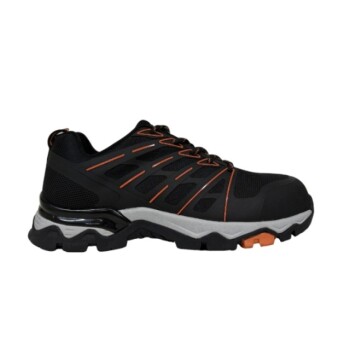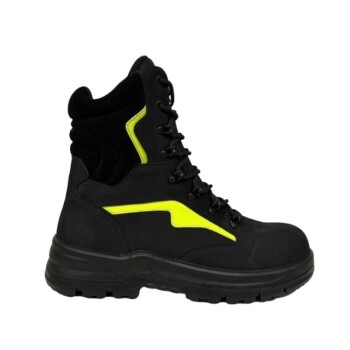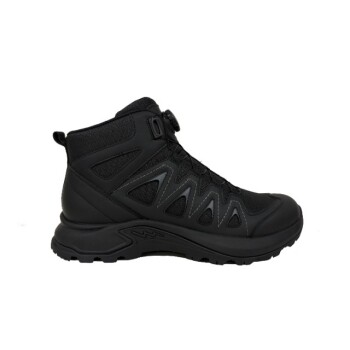The two primary factors that increase the risk of slipping when wearing boots are physical sole wear and chemical degradation. Worn-down treads reduce the boot's ability to grip, while exposure to substances like oils, solvents, and animal fats can cause the sole material to swell and lose its effectiveness.
The safety of your footwear is not static; it degrades over time. Both visible wear and invisible chemical damage to the sole directly compromise its ability to prevent a fall.
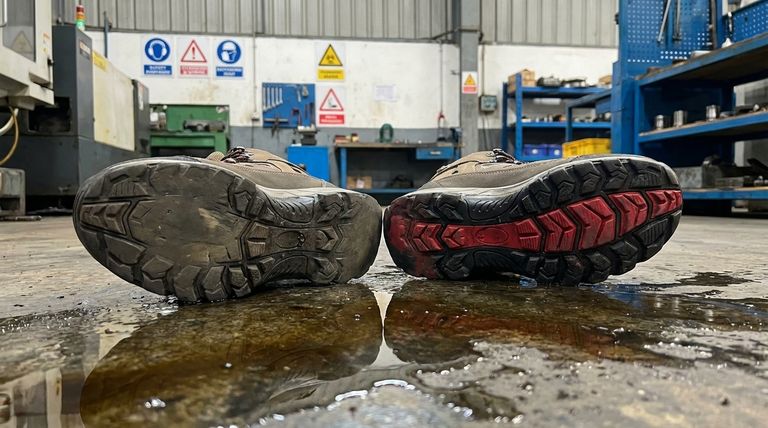
How Your Boot's Outsole Prevents Slips
To understand the risks, we first need to understand how a boot's sole is designed to provide stability and traction.
The Function of Treads
Treads are the patterns of grooves and channels on the bottom of your boot. Their primary job is to channel water, oil, and other contaminants away from the contact points between the sole and the ground.
This channeling action ensures that the solid parts of the sole can make direct contact with the surface, maximizing friction and preventing hydroplaning.
The Importance of Material Integrity
The rubber or synthetic compound used for the outsole is specifically engineered for grip and durability. Its chemical composition determines its resistance to abrasion and its coefficient of friction on various surfaces.
Key Factors That Increase Slip Risk
When the design or material of the outsole is compromised, your risk of slipping increases dramatically.
Physical Sole Wear
As you walk, the treads on your boots naturally wear down. Over time, these channels become shallow and less defined.
Worn, smooth soles can no longer effectively clear away fluids. This leaves a thin layer of liquid between your boot and the floor, significantly reducing friction and creating a major slip hazard.
Chemical Degradation and Swelling
Exposure to certain chemicals is a less obvious but equally dangerous risk. Solvents, oils, and animal fats can be absorbed by the rubber of the outsole.
This absorption causes the material to swell, soften, and lose its structural integrity. A swollen sole may feel spongy and will not grip surfaces as it was designed to, even if the treads appear intact.
Common Pitfalls to Avoid
Recognizing the risks is only half the battle. You must also avoid common assumptions that can lead to an accident.
The "Good Enough" Misconception
Many people continue to wear boots long after their effective lifespan has ended. A boot might look fine from the top, but a worn or chemically damaged sole is a hidden danger.
Relying on a visual check of the boot's upper portion is a mistake. Safety begins and ends with the condition of the outsole.
Assuming All Boots Are Equal
A boot designed for a construction site may not have a sole compound that can resist the animal fats found in a commercial kitchen. Using the wrong boot for the environment can accelerate chemical degradation and failure.
Always ensure your boot's specifications match the hazards of your specific workplace or environment.
How to Apply This to Your Safety Routine
Your choice and maintenance of footwear should be an active part of your safety protocol.
- If your primary focus is daily safety: Regularly inspect your boot soles for significant tread wear and any signs of swelling, sponginess, or discoloration that could indicate chemical damage.
- If your primary focus is purchasing the right gear: Choose boots with outsoles specifically rated as "slip-resistant" or "oil-resistant" if your environment involves exposure to fluids or chemicals.
- If your primary focus is extending boot lifespan: Clean your boots regularly, especially after exposure to oils or solvents, to prevent these substances from soaking in and degrading the sole material.
Understanding how your boots fail is the first step toward ensuring they never do.
Summary Table:
| Factor | Description | Resulting Risk |
|---|---|---|
| Physical Sole Wear | Treads wear down, becoming shallow and less defined. | Reduced ability to channel fluids, leading to hydroplaning and loss of grip. |
| Chemical Degradation | Exposure to oils, solvents, or fats causes the sole to swell and soften. | The sole loses its structural integrity and grip, even if treads look intact. |
Don't let compromised footwear be your weakest link. As a large-scale manufacturer, 3515 produces a comprehensive range of safety footwear for distributors, brand owners, and bulk clients. Our production capabilities encompass all types of slip-resistant and oil-resistant shoes and boots, engineered with durable outsoles to withstand the specific hazards of your work environment. Ensure your team's safety with reliable footwear designed for performance and longevity.
Contact us today for a consultation and let us help you select the right boots for your needs.
Visual Guide
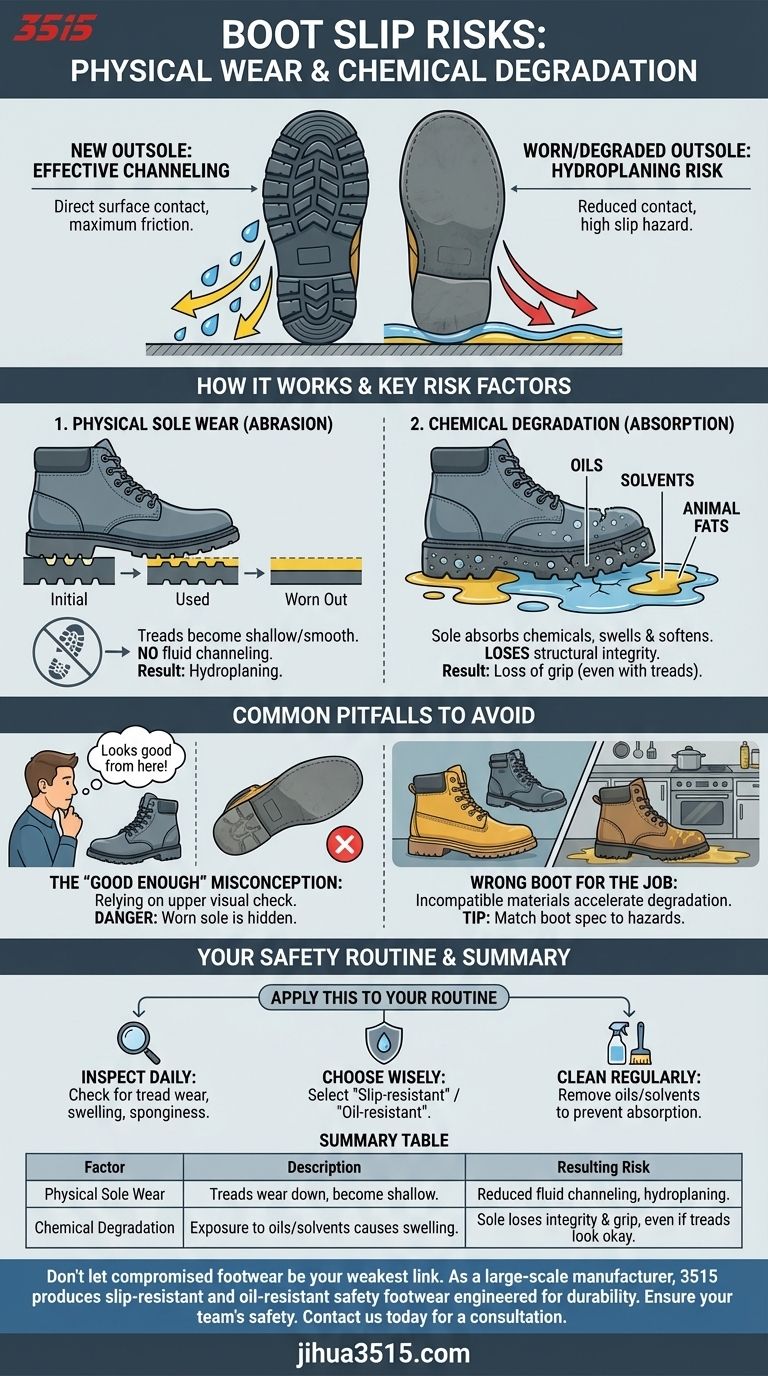
Related Products
- Safety Footwear Wholesale Manufacturer for Custom OEM/ODM Production
- Premium Flame-Retardant Waterproof Safety Boots and Shoes
- Customizable Anti-Smash Safety Boots for Wholesale & Private Label Manufacturing
- Premium Grain Leather Safety Boots for Bulk Supply
- Premium Wholesale Waterproof Safety Boots High Performance Protection for Industrial Markets
People Also Ask
- What are OSHA approved shoes? Understanding the Correct Standards for Workplace Safety
- What are the differences between steel toe, composite toe, and alloy toe Wellington boots? Choose the Right Safety Toe for Your Job
- Is safety-toe as good as steel toe? Choose the Right Protection for Your Job
- Do snake bite boots work? Your Ultimate Guide to Effective Snake Bite Protection
- What are the cultural perspectives on wearing shoes in the house? A Guide to Home Etiquette & Hygiene







